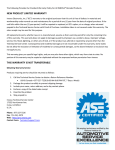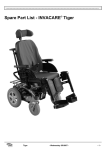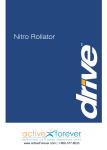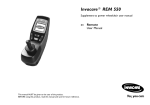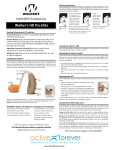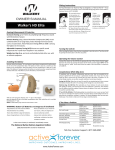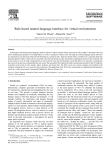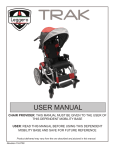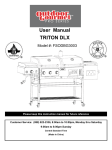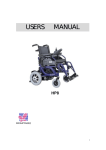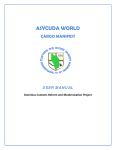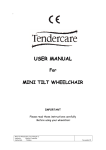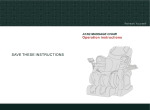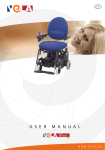Download Karman Stand Up Wheelchair User Manual
Transcript
INSTRUCTION MANUAL POWER STAND UP WHEELCHAIR KARMAN HEALTHCARE INC. City of industry, CA 91748 **Karman Healthcare Inc. Recommends Patient Seek Physicians Counsel Before Purchase www.Activeforever.com Table of Contents P.3 XO-202: Parts Explanation Chapter 1. SAFETY TIPS 1-1. Standing 1.2. Important symbols found on the vehicle 1-3. Safety information on driving and freewheel mode 1-4. Rear wheels 1-5. Armrests 1-6. Power drive attachments 1-7. Modifications Chapter 2. UNPACKING AND PREPARING THE STAND UP WHEELCHAIR XO-202 STAND UP WHEELCHAIR FOR USE 2-1. The original package and accessories. 2-2. Unfolding the stand up wheelchair Chapter 3. ADJUSTMENT 3-1. Adjusting the seat depth 3-2. Adjusting the backrest height 3-3. Adjusting the footrest height 3-4. Adjusting the footrest angle 3-5. The knee support and safety belt and chest belt 3-6. Adjusting the armrest height 3-7. The heel strap 3-8. Gas spring 3-9. The seat cushion Chapter 4. DRIVING 4-1. Before Driving for the First Time 4-2. Taking obstacles 4-3. Driving up and down gradients 4-4. Free wheeling Chapter 5. OPERATION THE STANDING AND SITTING Chapter 6. CONTROL SYSTEM 6-1. The SHARK II Remote 6-2. Battery and control box connection 6-3. Battery charge Chapter 7. MAINTENANCE & WARRANTIES 1 XO-202 Series 07 01 02 08 03 09 04 10 11 05 12 06 01 Backrest 07 Armrest 02 Chest belt 08 Controller Chest belt 03 Side Panel 09 Seat Rest 04 Rear Wheel 10 Knee Support Set 05 Motor/Differential Gear 11 Footrest 06 Front Wheel 12 Stand Up Casters 2 Chapter 1. SAFETY TIPS Powered Chair Electromagnetic Interference (EMI) WARNINGS The following warning listed below should reduce the chance of unintended brake release or powerchair movement, which could result in serious injury. 1. Do not operate hand-held transceivers (transmitter-receivers), such as citizens band (CB) radios, or turn ON personal communication devices, such as cellular phones, while the Powerchair is turned ON. 2. Be aware of nearby transmitters, such as radio or TV stations, and try to avoid coming close to them. 3. In unintended movement or brake release occurs; turn the Powerchair OFF as soon as it is safe. 4. Be aware that adding accessories or components, or modifying the Powerchair may make it more susceptible to EMI. 1-1. Standing Attention: • Before you turn off the power wheelchair please make sure to wait for 10 seconds. Otherwise, wheelchair seat may move up slightly but this is just the gas spring relieving pressure. • Standing up stresses your body in ways you may not be used to. You should consult your doctor or physical therapist before using the stand-up wheelchair. • Before using the stand up wheelchair you should be familiar with its operation and functions. • • • Use only on hard even surface. Do not drive on wet surfaces. In case of a staircase, the stand up wheelchair must be carried by 2 persons. When riding on, standing with or leaving from the stand up wheelchair keep the user’s feet firmly placed upon the footplates to avoid dangerous positions. • Before standing up it is absolutely vital that the knee support, safety belt and chest belt are wrapped securely around the user. WARNING: Maximum weight limit should not exceed XO-202: 250 lbs. 3 1-2.Important symbols found on the vehicle DO NOT DRIVE OVER UNEVEN GROUND! Danger of tipping over! DO NOT LEAN OUT OF THE RAISED VERTICALIZER! Danger of tipping over! NEVER DRIVE ON ASCENDING OR DOWNWARD SLOPES WHEN THE VERTICALIZER IS RAISED! Danger of tipping over! NEVER REACH INTO THE MOVING APPARATUS OF THE RAISED VERTICALIZER! Danger of crushing! 1-3 Safety Information on Driving and Freewheel Mode Danger of injury if the wheelchair tips over ● Only negotiate gradients up to the maximum tilt-resistant gradient and only with the backrest and seat tilt in a seated position. ● Only drive downhill at a maximum of 2/3 of the top speed! Avoid abrupt braking or acceleration on gradients. ● If at all possible, avoid driving on slippery surface (such as gravel) where there is a danger of you losing control over the vehicle, especially on a gradient! If driving on such a surface is inevitable, then always drive slower and with the utmost caution. ● Never attempt to overcome an obstacle when on an uphill or downhill gradient! ● Never attempt to drive up or down a flight of steps with your wheelchair! ● Approach any and all obstacles straight on. Ensure that the front wheels and rear wheels move over the obstacle in one stroke! Do not stop halfway! Do not exceed the maximum obstacle height! ● Avoid shifting your center of gravity, any abrupt joystick movements or swift changes of direction when the wheelchair is in motion! ● Never use the wheelchair to transport more than one person! ● Do not exceed the maximum permissible load! 4 ● Note that the wheelchair may brake or accelerate if you change the Driving Mode while the wheelchair is in motion! 1-4. Rear Wheels CURBS, INCLINES AND RAMPS Always practice with your healthcare professional or attendant before attempting to negotiate curbs, inclines or ramps alone. It is important for you to develop a safe technique that is suitable to your abilities. WARNING: Doing a “wheelie” (tilting the wheelchair backward to its balance point) can be dangerous. Do not attempt this maneuver without an attendant. 1-5. Armrests Flip-back Armrests Never lift the wheelchair by the flip-back armrests. These parts are detachable and lifting the wheelchair by them may cause damage to the chair or injury to the user. 1-6. Power Drive Attachments Karman Healthcare Inc. does not advocate any drive attachments on the XO-202 series wheelchair. Use of a power drive attachment on XO-202 series wheelchair alters its intended use. Installation of a power drive attachment is considered an alteration to the frame and voids the warranty. 1-7. Modifications Marking any unauthorized modifications or using parts not supplied by Karman Healthcare Inc. may change the wheelchair structure and create an unsafe condition voiding the warranty. This product has been supplied from an environmentally aware manufacturer that complies with the Waste Electrical Equipment (WEEE) Directive 2002/96/CE. Please be environmentally responsible and recycle this product at the end of its life through your local recycling facility. This product may contain substances that could be harmful to the environment if disposed of into a landfill. Chapter 2. UNPACKING AND PREPARING THE POWER STAND UP WHEELCHAIR XO-202 SERIES FOR USE 2-1. List of Included Accessories and Components: • • • • • • Power stand up wheelchair wheel strap & chest belt Knee support Charger (USA users check charger switch is set to 115VAC) Oil pot User Manual and Tool Options as ordered 5 2-2. Unfolding the Stand up Wheelchair Please Proceed as Follows: • • Remove any transport straps or transport guards. Grasp the wheelchair at the backrest and pull backward and then push downward up to stop. (Fig. 1 & 2) • • • Tighten the knob on the left and right. (Fig. 3) Press the flip-back armrest forward. Connect the DC power line to power socket of battery. 1 2 3 Chapter 3. ADJUSTMENT Should you require adjustments and alterations to the mechanism of the wheelchair, or any maintenance work, please contact qualified technicians. 3-1. Adjusting the Seat Depth (1)Pull upward(push forward on the joystick) and the wheelchair frame will rise over the rear wheel. (2)After loosening the left and right side screws the seat depth can be adjusted using the different holes at 1” distance. (Fig- 4 ~ 6) (3)Retighten the left and right both side screws.(Fig- 7 & 8) 4 5 6 3-2. Adjusting the Backrest Height (Fig-9 ~12) (1) Remove the backrest padding. (2) After removing the screws, the backrest height can be adjusted using the Allen wrench at 2 cm. intervals. (3) Retighten the screws. 7 9 10 11 12 7 3-3. Adjusting the Footrest Height The height of the footrest is adjustable and should be adjusted to compliment your body proportions to guarantee the best and most comfortable standing position possible. Footrest adjustment should also take account of your choice of seat cushion. (Fig-13 ~ 16) 13 14 16 15 • • After loosening the screws the footrest height can be adjusted using the different holes at 1.8cm. intervals. Retighten the screws.(not too tight) 3-4. Adjusting the Footrest Angle • • After removing the screws the footplate angle can be adjusted using a different hole at 10° incline angle. (Fig-17 & 18) Retighten the screws.(Fig-19) 17 18 8 19 3-5. The Knee Support, Safety Belt and Chest Belt The most important safety features of the stand-up wheelchairs are the knee support, safety belt and chest belt. It is absolutely essential that these be correctly fastened around the user before attempting to stand up. 3-5-1. The knee support The knee support holds the knees in an extended posture and prevents the user from slipping out of the power wheelchair when standing up. Attach both of the triangular hooks over the locking pins on both sides of the wheelchair.(Fig-20) 20 Center the knee support cushion in front of each knee using the Velcro fasteners then pull it until it rests firmly just below, (not right on), the knee cap. Do not make it too tight. (Fig-21) 21 3-5-2. The safety belt(Fig-22) • • The safety belt holds the waist in place. Make sure that the safety belt is securely attached to the frame of the backrest. • Fasten the safety belt across your waist but not too tight. • To release the safety belt. Simply press the red button in the center of the latch. • To slacken, hold the latch-end at a right angle to the belt and pull. 22 3-5-3. Adjusting the chest belt(Fig-23 ~ 25) • • Make sure that the chest belt is securely fastened to the frame of the backrest. The chest belt holds the user’s upper body (chest) when in a standing position. 9 23 24 25 3-6. Adjusting the Armrest Height (1) Release the left and right screws up to the clamp, they can be removed to suit desired position.(Height 7”~10”) (Fig-26 & 27) (2) Retighten the screws of the clamp. 26 3-7. The Heels Strap (Fig-28) 27 28 The purpose of the heel strap is to prevent the legs and feet from slipping backwards. It is fitted behind the heels or higher. By making use of the Velcro fastening it is possible to alter the length of the strap and ensure the best positioning for the feet on the footrest. 3-8. Gas Spring The gas springs are specially designed to help hold your body weight in balance. NOTE: Contents under pressure. Do not, under any circumstances take apart, puncture, apply heat or fire! 3-9. The Seat Cushion The Velcro fasteners prevent the cushion from slipping out of place even when you are standing up. The height of the footrest should be adjusted to take into account the height of a given seat cushion. Once the knee support, safety belt and chest belt are fitted correctly you are ready to stand up. 10 Chapter4. DRIVING 4-1 Before Driving for the First Time Before you take your first trip, you should familiarize yourself well with the operation of the vehicle and with all operating elements. Take your time to test all functions and driving modes. Attention: • • You are within easy reach of all operating controls. The battery charge is sufficient for the distance intended to be covered. 4-2 Taking Obstacles Your electric wheelchair is able to overcome obstacles and curbs to a maximum height of 4cm. WARNING: • • • Never approach obstacles at an angle! Put your backrest into an upright seated position before climbing an obstacle! Never drive over obstacles that are elevated at odd and sharp angles. Always take care in maneuvering any and all obstacles. 4-3 Driving Up and Down Gradients Your electric wheelchair has a maximum tilt-resistant climbing ability of 17.6%. WARNING: • Only drive downhill at a maximum of 1/2 of the top speed. • Avoid sudden changes of direction or abrupt braking when driving on slopes. • Always return the backrest of your seat or the seat tilt to an upright seated position before ascending slopes. We recommend that you position the seat backrest or the seat tilt slightly to the rear before descending slopes. • The standing position is only used for stationary ascension and not for simultaneous drive operation. Return the wheelchair to a seating position before ascending a slope. • Never attempt to ascend or descend a slope on slippery surfaces or where there is a danger of skidding. • Avoid trying to get out of the vehicle on an incline or a gradient. • Always drive straight in the direction the road or path you are on goes, rather than attempting to zigzag. • Never attempt to turn around on an incline or a slope. DANGER: • The standing position only serves positioning and not normal driving. • Never drive over uneven terrain, on an upward or downward slope obstacles when in the standing position. 11 4-4 Free Wheeling: Because the motors are designed to engage the electromagnetic brakes when the vehicle is not in use or when the power is OFF. There is also a manual feature that allows them to “free-wheel”. Free- wheeling is accomplished by pulling the free- wheeling levers to the free-wheeling position. (Fig29) 29 WARNING: • Never free-wheel your power wheelchair on a slope. • Never free-wheel the motors while operating your vehicle. • Always remember to engage the motors before turning the power back ON. Chapter 5. OPERATION THE STANDING AND SITTING 1. First, adjust and secure the knee support and make sure that both triangular hooks of the knee support lock over double-head screws of the frame. (Fig-30 & 31) 30 31 2. Attach the safety belt.(Fig-32) 3. Attach the chest belt.(Fig-33) 12 32 33 4. Pull upward(push forward on the joystick) and the wheelchair will go into stand up position. 5. Push downward(pull backward on the joystick) and the wheelchair will return to sitting position. Caution: • • Make sure your hand is not under the stand up mechanism. Make sure there are no children behind or near the wheelchair. Chapter 6. CONTROL SYSTEM 6-1. The SHARK II Remote Introducing SHARK SHARK heralds the dawn of new thinking in lower cost power chair control solutions. Using a dedicated power module and control unit, SHARK has none of the compromises that go into the design of one-box controllers - this means more power, unrivaled ergonomics, greater versatility and superior usability. • Features Dynamic’s breakthrough “Chair Tamer” technology, providing unprecedented chair performance, control and safety. • A number of control units are available to meet a wide range of user needs. These range from optimally small, highly ergonomic units to units with a more traditional appearance and standard functionality. • A choice of power modules offers basic ‘drive only’ functionality up through sophisticated modules supporting multiple seat adjustments, lights, etc. • • No heavy power cables running from the armrest to the motors and batteries. No hot surfaces for the user to touch. 13 Using the Seat Function Button (REMD11 & REMD21 Only) 1. Two seat functions are available for individual adjustment and are accessed via the Seat Function Button, (pictured at left). Seat Function 1 is “Stand-up Mode” and Seat Function 2 is normal “Seat Mode.” 2. Press the Seat button once to toggle the control unit from Drive mode to Seat mode. Seat Function 1 will be active as noted by the amber colored “1” LED. Seat Function 2 does not light up. 3. To adjust Seat Function 1, use the joystick Forward/Reverse to Rise/Descend from standing position. 14 Charging SHARK Plug the battery charger into the charging socket located at the front of the SHARK Control Unit. The SHARK Battery Gauge will indicate the system is being charged by cycling between a left-to-right chase and displaying the current battery state-of-charge. Driving is prevented (inhibited) while the system is being charged. Once the Battery Charger displays a ‘full’ battery charge, the battery charger plug may be removed. If SHARK is turned off, or goes into sleep while charging, charging will continue. Although the SHARK Information Gauge will display an approximate battery level while charging, the Battery Charger should be used as the sole judge of charge completion. Assembly of the remote 1. Battery gauge 2. ON/OFF 3. Activate / connect through / deactivate adjusting mode 4. Decrease speed 5. Speedometer 6. Horn 7. Increase speed 8. Attendant control LED 9. Service indicator LED 10. Joystick Lower side 1. Combined charging socket / programming socket 15 6-2. Battery and Control Connection The main electrical control system is composed of motor, control box battery and controller. The connection of the control system is as follows. Stand up Motor 6-3. Charging Battery 1. First make sure that the battery charging line connects to the battery DC power socket and that the line is connected correctly. 2. Connect the AC power line to the AC socket.(110~220V) 3. The light of the battery charger goes from yellow color to green color and represents the battery’s charge. When the battery capacity is low, it will stop working. Attention: 1. Check the battery capacity before and after ever use. 2 . A new battery must be charged over 8 hours. 3. Charge your battery with the battery charger provided by manufacturer only. 6-4. Main Circuit Breaker (Only for your information, do not tamper with it) The mean circuit breaker reset button is located on the battery box. (Fig. 31). The main circuit breaker monitors the electric current drawn form the battery. It is a safety feature built into your wheelchair for your safety. The entire electric system of the wheelchair is protected by the main circuit breaker against overloading. 31 16 Chapter 7. MAINTENANCE • When cleaning your XO-202 series, use a dry or slightly moistened cloth to wipe the wheelchair down. For stubborn or oily stains, apply a mild detergent to the cloth. Do not hose down your XO-202 series with water. • Depending on the frequency of use, check tire pressure between once a week and once a month. If necessary, pump up the tires in line with manufacturer’s recommendations. • Check the state of the tread on the tires every one to six months. If a tire is heavily or unevenly worn, it should be replaced. • Every one to six months, check that the brakes still work reliably. Having applied the brakes, the wheels should stop turning completely. If the brakes are ineffective, they should be tightened up. • Depending on frequency of use, lubricate the knee joint between once a week to once a month. (Fig-32~34) 32 33 WARNING! To inspect or replace the motor brushes: 1. Unscrew the motor brush caps. (See Fig 35) 2. Remove the brushes. 3. Inspect the brushes for wear (See Fig 36) 4. Replace the brushes if necessary. 35 36 17 34 FLASH CODES Flash codes indicate the nature of an abnormal condition directly from the SHARK Information Gauge. Without the use of any servicing tools, the condition can be simply diagnosed. Flash Code 1 Description User Fault 2 Battery Fault Possible stall timeout or user error. Release the joystick to neutral and try again. Try charging the batteries. Batteries may require replacing. 3 4 5 6 7 Left Motor Fault Right Motor Fault Left Park Brake Fault Right Park Brake Fault SHARK Remote Fault 8 SHARK Power Module Fault SHARK Communications Check the batteries and cabling. Check the left motor, connections and cabling. Check the right motor, connections and cabling. Check the left park brake, connections and cabling. Check the right park brake, connections and cabling. Check the SHARK Communications Bus connections and wiring. Replace the Remote. Check SHARK connections and wiring. Replace the Power Module. Check Battery voltage is greater than 17V. Check SHARK Bus Cable. Fault Replace the SHARK Power Module. 9 10 Unknown Fault 11 Incompatible Remote Replace the SHARK Remote. Check all connections and wiring. Consult a service agent. The Remote is incompatible with the Power Module. Ensure the brand of the power Module matches that of the remote. 18 *****WARNING***** This chair is not intended for those who have: -Lower limbs joint contracture (absolute contra-indication) -Total hip replacement (THR) and total knee replacement (TKR) -Instability on lower extremity joints -Severe osteoporosis on lower extremities -Severe abnormal reflex (lower extremities withdraw reflex) -Severe postural hypotension -Low-shearing seat will be suggested to those who use positioning system 19 WARRANTIES Frame 3 Years Electrical 1 Year Parts Motor/Transaxle/Brake 6 Months 1 Year 1. Structural frame components including platform, fork, seat post and frame welds are warranted, to the original owner/ 2. To present a claim, Customer shall deliver the defective part for exchange or repair if possible to an Authorized Karman provider. 3. This warranty is for the replacement or repair, at the option of Karman Healthcare Inc., of defective parts only and does not cover any labor charges including, but not limited to, charges incurred for installation of replacement parts or additional fees, which may be imposed by Karman Healthcare Inc. 4. All warranty replacement parts are under warranty from the date of purchase of the original “product” and not from the date of part replacement. 5. This warranty is valid and enforceable only on “products” purchased in the United States and from a Karman provider. 6. This warranty is applicable only to the customer as an original purchaser of the “product” from an Authorized Karman provider and shall not apply to any subsequent purchaser, assignee or other recipient of the power chair from customer. 7. No provider or other similar person has any authority to make any warranties or representations concerning Karman Healthcare Inc. products, or to extend this warranty beyond the expressed terms contained within. Distributor assumes no responsibility for any warranties beyond the expressed terms contained in the warranty. Customer releases and holds distributor harmless from any claims stemming from any unauthorized representations. 8. This warranty does not apply unless the Registration Card is signed completed and returned within thirty days (30) from the date of purchase. 9. Warranty Exceptions: A. Transaxle: In cases where there is an increase in the operational noise level, the warranty will not apply. B. Motor: If damage occurs as a result of not replacing motor brushes after heavy wear to brushes. 10. This warranty does not cover batteries or damage caused by battery leakage. The battery manufacturer covers warranty. 11. This warranty does not cover plastic covers; seat upholstery, tires, or armpads these are considered wear items. 12. All transportation costs and shipping damage incurred while submitting parts for repair or replacement are the responsibility of the original purchaser. 13. This warranty does not apply to any injury, loss, defect or malfunction of the “product” or failure to function resulting from any failure to operate or maintain “product” in accordance with the directions contained in the owners manual provided by Karman; or any injury, loss, damage or malfunction, or failure to function resulting from any accident, acts of God, alterations in the “product” by anyone other than the distributor, or misuse, unreasonable use, tampering, abuse, acts, omissions, failure or negligence by anyone other than the manufacturer. 20





















